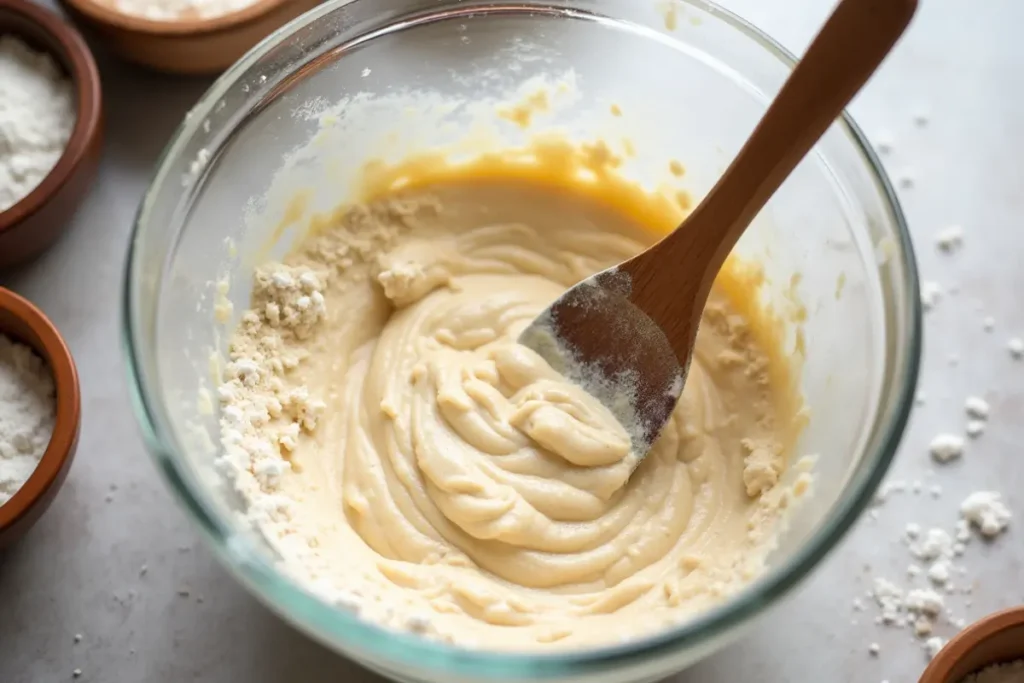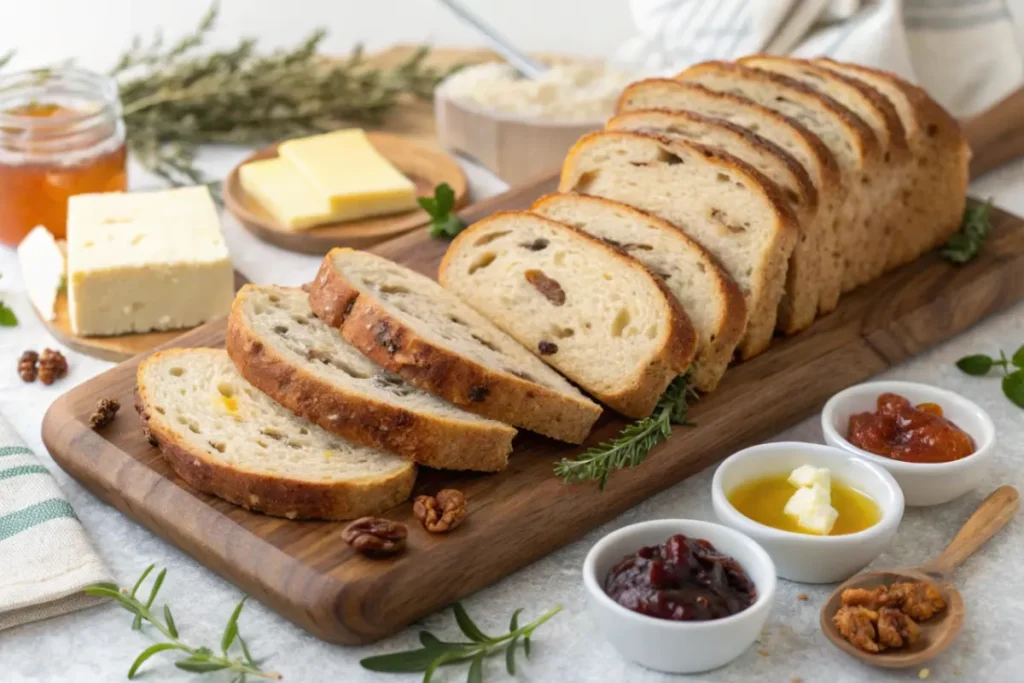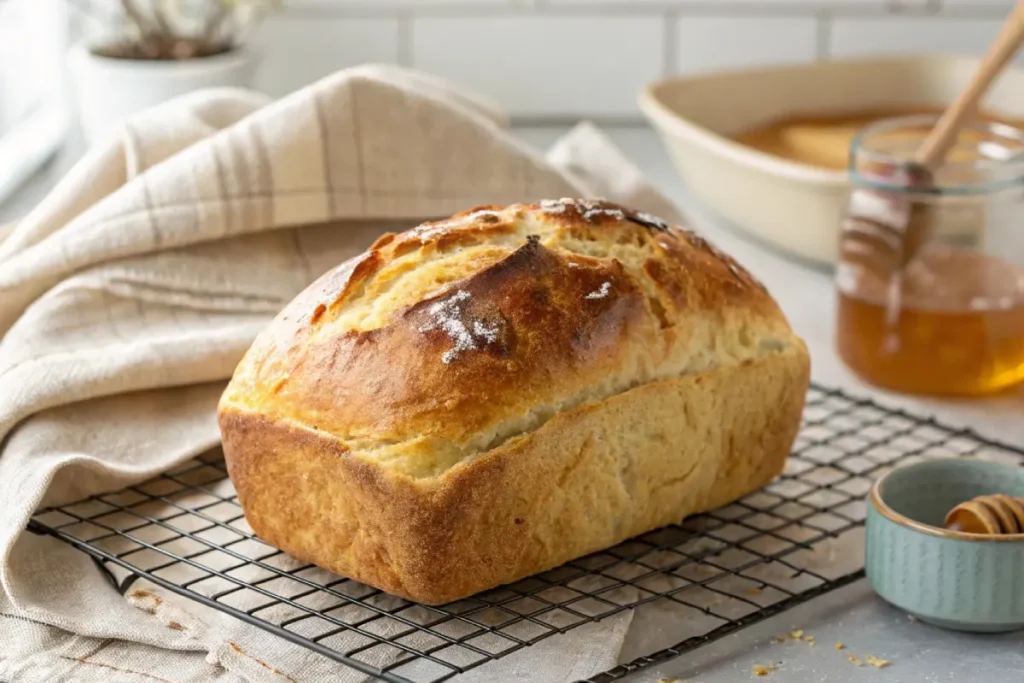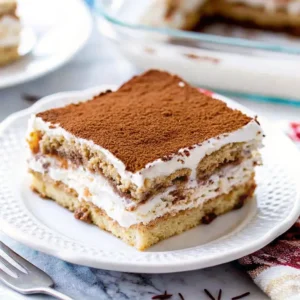Sourdough quick bread offers the tangy goodness of traditional sourdough in a fraction of the time. Perfect for beginners or anyone craving fresh bread without hours of waiting, this type of bread combines convenience with exceptional taste. In this article, you’ll learn the essentials of sourdough quick bread, its benefits, and how it differs from traditional baking methods. Let’s dive in!
Table Of Contents
Table of Contents
Understanding Sourdough Quick Bread
What Defines Quick Bread?
Quick bread refers to any bread that uses chemical leavening agents like baking powder or baking soda instead of yeast or a lengthy fermentation process. These breads are popular for their speed and ease, requiring no kneading or extended proofing. Examples include muffins, banana bread, and cornbread.
- Key Characteristics of Quick Bread:
- Fast preparation time
- No need for yeast or a long-rise
- Typically baked immediately after mixing
Is Sourdough Considered a Quick Bread?
Sourdough bread traditionally relies on natural fermentation, making it a slower process. However, sourdough quick bread merges the two worlds by using a sourdough starter for flavor while incorporating baking powder or soda for leavening.
- How It Fits the Quick Bread Category:
- Uses sourdough starter primarily for flavor, not leavening
- Incorporates chemical leaveners for a faster rise
Key Differences Between Sourdough Quick Bread and Traditional Quick Bread
While both types are quick to prepare, sourdough bread stands out for its distinctive tang and depth of flavor, courtesy of the sourdough starter.
- Flavor Profile:
- Traditional quick bread: Mild and straightforward
- Sourdough quick bread: Complex and tangy
- Texture Comparison:
- Traditional quick bread: Soft and crumbly
- Sourdough quick bread: Slightly denser with a tender crumb
By understanding these fundamentals, you can appreciate what makes sourdough quick bread unique and why it’s worth adding to your recipe repertoire.
The Benefits of Sourdough Quick Bread
Nutritional Perks of Sourdough
Sourdough quick bread isn’t just about convenience; it’s also a healthier choice. Thanks to the fermentation process involved in making the starter, sourdough bread offers unique benefits.
- Improved Digestibility:
- The fermentation process breaks down gluten, making it easier to digest.
- Beneficial bacteria from the sourdough starter aid gut health.
- Rich in Nutrients:
- Sourdough retains more vitamins and minerals compared to traditional bread.
- Contains magnesium, iron, and B vitamins essential for energy and immunity.
Why Sourdough Bread is Not Fattening
Despite being bread, sourdough is often considered less fattening due to its lower glycemic index (GI).
- Lower GI Benefits:
- Sourdough digests slowly, keeping blood sugar levels stable.
- It can help curb appetite and prevent overeating.
- Healthier Carbohydrate Profile:
- The fermentation process alters the starches, making them less likely to spike insulin levels.
- This makes sourdough a smart option for weight-conscious individuals.
Healthier Ingredients in Sourdough Quick Bread Recipes
Sourdough quick bread recipes often use simple, wholesome ingredients like whole grains, nuts, and seeds.
- Wholesome Choices:
- Whole wheat or rye flour for added fiber.
- Olive oil or yogurt as healthier fat options.
- Natural Preservatives:
- The acidity in sourdough helps keep the bread fresh longer without artificial additives.
By incorporating sourdough quick bread into your diet, you’re not just indulging in delicious flavors; you’re also choosing a nutritious, body-friendly option.
Looking for more healthy inspirations? Don’t miss our guide to Vegetarian Lentil Loaf.
Essential Ingredients for Sourdough Quick Bread Recipes
Sourdough Starter: The Star Ingredient
The sourdough starter is what gives sourdough quick bread its signature tangy flavor. Unlike traditional sourdough bread, where the starter acts as the primary leavening agent, here it’s mainly for flavor enhancement.
- What is a Sourdough Starter?
- A fermented mixture of flour and water teeming with natural yeast and bacteria.
- Provides depth of flavor and slight acidity.
- How to Use it in Quick Bread:
- Incorporate ½ to 1 cup of starter to infuse the bread with tang without affecting the rise.
- Use a mature starter for the best flavor.
Flour Choices: Whole Wheat vs. All-Purpose
Choosing the right flour can impact the texture, flavor, and nutritional content of your bread.
- Whole Wheat Flour:
- Adds nuttiness and extra fiber.
- Best paired with sweet or savory variations to balance its robust flavor.
- All-Purpose Flour:
- Creates a lighter, fluffier bread.
- Ideal for delicate flavors like lemon or vanilla.
- Mixing Flours for Balance:
- Combine whole wheat and all-purpose flour for a blend of texture and nutrition.
Optional Add-Ins for Extra Flavor
Sourdough quick bread is versatile, allowing for creative additions to suit your taste.
- Sweet Add-Ins:
- Dried fruits like raisins, cranberries, or apricots.
- Nuts such as walnuts or almonds for crunch.
- Sweeteners like honey, maple syrup, or brown sugar.
- Savory Add-Ins:
- Fresh or dried herbs like rosemary, thyme, or oregano.
- Cheese (cheddar, parmesan) or chopped olives for a hearty twist.
- Seeds like sunflower, sesame, or chia for texture and health benefits.
Mastering these key ingredients allows you to tailor your sourdough quick bread to any flavor or occasion.

How to Speed Up Sourdough Quick Bread Baking
Tips for Accelerating Fermentation
While sourdough starters usually require time to ferment and develop flavor, quick bread recipes use chemical leaveners to save time. Here’s how to speed up the process without compromising quality:
- Warm Ingredients:
- Use room-temperature sourdough starter and eggs for better rise.
- Slightly warm liquids like milk or water (not hot!) to encourage activity.
- Boost Starter Activity:
- Feed the sourdough starter a few hours before using it in your recipe.
- Add a pinch of sugar to give the starter an energy boost.
- Quick Warm-Up Trick:
- Place the batter in a warm, draft-free area (like an oven with the light on) before baking for a quick lift.
Using Baking Soda and Powder Effectively
The secret to quick bread lies in chemical leaveners, which react instantly with acids in the batter, creating the rise.
- Balancing Leaveners:
- Use both baking soda and baking powder for optimal texture.
- The sourdough starter’s acidity pairs well with baking soda for a light, airy crumb.
- Timing is Everything:
- Mix the leavening agents into the batter just before baking to maximize their reaction.
- Avoid overmixing the batter to prevent deflation.
Time-Saving Equipment and Techniques
Investing in the right tools and techniques can make the baking process faster and more efficient.
- Recommended Tools:
- Stand mixer or hand mixer for quick and even batter preparation.
- Non-stick loaf pans or silicone molds for faster baking and easy cleanup.
- Shortcut Techniques:
- Preheat the oven while preparing the batter to save time.
- Prepare dry and wet ingredients separately in advance for efficient mixing.
By adopting these tips and tricks, you can enjoy homemade sourdough quick bread in record time without sacrificing flavor or quality.
Looking for more time-saving ideas? Discover our Mini Pancakes Recipe for a quick and delicious breakfast option.
Step-by-Step Recipe for Classic Sourdough Quick Bread
Ingredients List and Measurements
To make a simple yet delicious sourdough quick bread, gather the following:
- Dry Ingredients:
- 2 cups all-purpose flour (or a mix of whole wheat and all-purpose)
- 1 tsp baking powder
- ½ tsp baking soda
- ½ tsp salt
- Wet Ingredients:
- 1 cup sourdough starter (fed or discard)
- ½ cup milk or buttermilk (room temperature)
- 2 large eggs (room temperature)
- ¼ cup melted butter or neutral oil
- 2 tbsp honey or maple syrup (optional for sweetness)
- Optional Add-Ins:
- Sweet: ½ cup raisins, dried cranberries, or chocolate chips
- Savory: ½ cup shredded cheese, herbs, or seeds
Step-by-Step Preparation Guide
- Prepare Your Workspace:
- Preheat the oven to 350°F (175°C).
- Grease a 9×5-inch loaf pan or line it with parchment paper for easy removal.
- Mix Dry Ingredients:
- In a large bowl, whisk together the flour, baking powder, baking soda, and salt.
- Set aside.
- Combine Wet Ingredients:
- In a separate bowl, whisk the sourdough starter, milk or buttermilk, eggs, melted butter, and honey.
- Incorporate Wet and Dry Mixtures:
- Gradually pour the wet ingredients into the dry ingredients.
- Stir gently until just combined; overmixing can lead to a dense loaf.
- Add Optional Mix-Ins:
- Fold in your chosen sweet or savory add-ins for extra flavor.
- Transfer to the Pan:
- Pour the batter into the prepared loaf pan, spreading it evenly with a spatula.
- Bake to Perfection:
- Place the pan in the oven and bake for 45-50 minutes, or until a toothpick inserted in the center comes out clean.
- Cool and Enjoy:
- Let the bread cool in the pan for 10 minutes before transferring it to a wire rack to cool completely.
Baking Tips for Perfect Texture and Flavor
- Avoid overmixing the batter to keep the bread light and fluffy.
- For a crispier crust, brush the top of the batter with melted butter before baking.
This classic recipe offers the perfect balance of tanginess and texture, making it a versatile base for any variation you want to try.
Creative Variations for Sourdough Quick Bread
Sweet Variations: Adding a Touch of Sweetness
Sourdough quick bread can be easily customized into a sweet treat for breakfast or dessert.
- Cinnamon Raisin Sourdough Quick Bread:
- Add 1 tsp cinnamon and ½ cup raisins to the batter.
- Swirl in 2 tbsp of brown sugar mixed with melted butter before baking for a marbled effect.
- Blueberry Lemon Sourdough Quick Bread:
- Fold 1 cup of fresh or frozen blueberries into the batter.
- Add 1 tbsp of lemon zest for a zesty aroma.
- Drizzle a lemon glaze (powdered sugar + lemon juice) over the cooled loaf for extra sweetness.
- Chocolate Chip Banana Sourdough Quick Bread:
- Replace ½ cup of milk with mashed bananas.
- Add ¾ cup of chocolate chips for a moist and indulgent loaf.
Savory Options: Perfect for Any Meal
Savory sourdough quick bread pairs wonderfully with soups, stews, or salads.
- Cheddar Herb Sourdough Quick Bread:
- Mix in 1 cup shredded cheddar cheese and 2 tbsp fresh herbs like chives, parsley, or dill.
- Sprinkle extra cheese on top for a golden crust.
- Garlic Rosemary Sourdough Quick Bread:
- Stir in 1 tbsp minced garlic and 2 tsp chopped rosemary.
- Brush with olive oil before baking for a rustic finish.
- Olive and Sun-Dried Tomato Sourdough Quick Bread:
- Add ½ cup chopped olives and ¼ cup chopped sun-dried tomatoes.
- Sprinkle with Italian seasoning for a Mediterranean twist.
Gluten-Free and Vegan Adjustments
For those with dietary restrictions, try these alternatives:
- Gluten-Free:
- Use a 1:1 gluten-free baking flour blend.
- Increase the liquid slightly if the batter feels thick.
- Vegan:
- Replace eggs with flaxseed or chia seed gel (1 tbsp seeds + 3 tbsp water per egg).
- Substitute milk with almond or oat milk and butter with coconut oil.

Common Mistakes and Troubleshooting Tips
Avoiding Dense and Gummy Bread
One of the most common issues with quick bread is ending up with a dense or gummy texture. Here’s how to prevent it:
- Measure Ingredients Accurately:
- Use measuring cups for dry ingredients and liquid measuring tools for wet ones.
- Too much flour or too little liquid can lead to dense bread.
- Don’t Overmix the Batter:
- Stir just until the dry ingredients are moistened.
- Overmixing develops gluten, resulting in a tough loaf.
- Check Baking Powder and Soda Freshness:
- Expired leaveners won’t produce the necessary lift.
- Test by dropping a pinch into vinegar (baking soda) or hot water (baking powder); it should fizz.
How to Handle Overproofed Dough
If your batter sits too long before baking, the leavening agents may lose their effectiveness.
- Quick Fixes:
- Stir in a small amount of fresh baking soda or powder right before transferring the batter to the pan.
- Reduce waiting time after mixing to avoid overproofing.
- Prevention Tips:
- Prepare the pan and preheat the oven before mixing to ensure immediate baking.
Fixing Flavor Imbalances in Sourdough
Sourdough’s tangy flavor is a signature, but it can sometimes overpower the bread.
- Too Tangy or Sour:
- Balance the acidity by adding a touch of honey, sugar, or vanilla extract to the batter.
- Use a less mature starter for a milder taste.
- Lacking Flavor:
- Allow the starter to ferment longer before using it.
- Incorporate flavorful mix-ins like herbs, spices, or citrus zest.
General Baking Tips for Success
- Test for Doneness:
- Insert a toothpick into the center; if it comes out clean, the bread is done.
- Cooling Matters:
- Let the loaf cool completely before slicing to prevent crumbling.
By mastering these troubleshooting tips, you’ll ensure consistent results with every bake.
Serving and Storing Sourdough Quick Bread
Best Ways to Serve Sourdough Quick Bread
Sourdough quick bread is versatile and complements many meals or snacks.
- For Breakfast:
- Toast slices and top with butter, jam, or honey for a quick start to your day.
- Pair with scrambled eggs, fresh fruit, or yogurt for a balanced meal.
- As a Snack:
- Serve with cream cheese, nut butter, or avocado for a satisfying midday bite.
- Enjoy alongside a cup of tea or coffee for an afternoon treat.
- With Lunch or Dinner:
- Use savory variations like cheddar herb as a side for soups or stews.
- Serve sweet versions as a dessert with whipped cream or fresh berries.
Pairing Ideas for Every Occasion
Sourdough quick bread shines when paired with complementary dishes.
- Soups and Stews:
- Cheddar Herb Sourdough pairs well with Chicken Butternut Squash Soup.
- Salads and Light Meals:
- Garlic Rosemary Sourdough is perfect with a fresh garden salad or roasted vegetables.
- Sweet Variations:
- Cinnamon Raisin Bread is delightful with a drizzle of maple syrup or cream cheese frosting.
Proper Storage to Maintain Freshness
To enjoy your sourdough quick bread for days, store it correctly.
- Short-Term Storage:
- Keep at room temperature for up to 3 days in an airtight container or wrapped in plastic wrap.
- Avoid refrigerating as it can dry out the bread.
- Long-Term Storage:
- Freeze the loaf or individual slices as described earlier for up to 3 months.
- Reheating Tips:
- Warm slices in a toaster or oven to refresh their flavor and texture.

Frequently Asked Questions About Sourdough Quick Bread
Is Sourdough Considered a Quick Bread?
Not traditionally, as sourdough relies on natural fermentation for leavening. However, sourdough quick bread uses a sourdough starter for flavor and chemical leaveners like baking powder or soda for a faster rise, making it a hybrid of both.
How Do You Speed Up Sourdough Bread?
To speed up the process, use warm ingredients and add baking powder or soda to the batter. Additionally, preheat the oven and prepare your ingredients in advance to reduce waiting time.
Why is Sourdough Bread Not Fattening?
Sourdough bread has a lower glycemic index than many traditional breads, meaning it digests slower and helps maintain stable blood sugar levels. It’s also more nutrient-dense due to the fermentation process, making it a healthier choice when consumed in moderation.
Is It Bad to Eat Sourdough Every Day?
No, eating sourdough daily is not harmful when it’s part of a balanced diet. Its natural probiotics and nutrients can support digestion and overall health. However, excessive consumption of any bread can contribute to calorie overload, so enjoy it responsibly.
By addressing these common concerns, you’re now fully equipped to enjoy and experiment with sourdough quick bread recipes confidently.
Looking for more? Don’t miss our Sourdough French Toast Recipe to turn your bread into a breakfast favorite!



